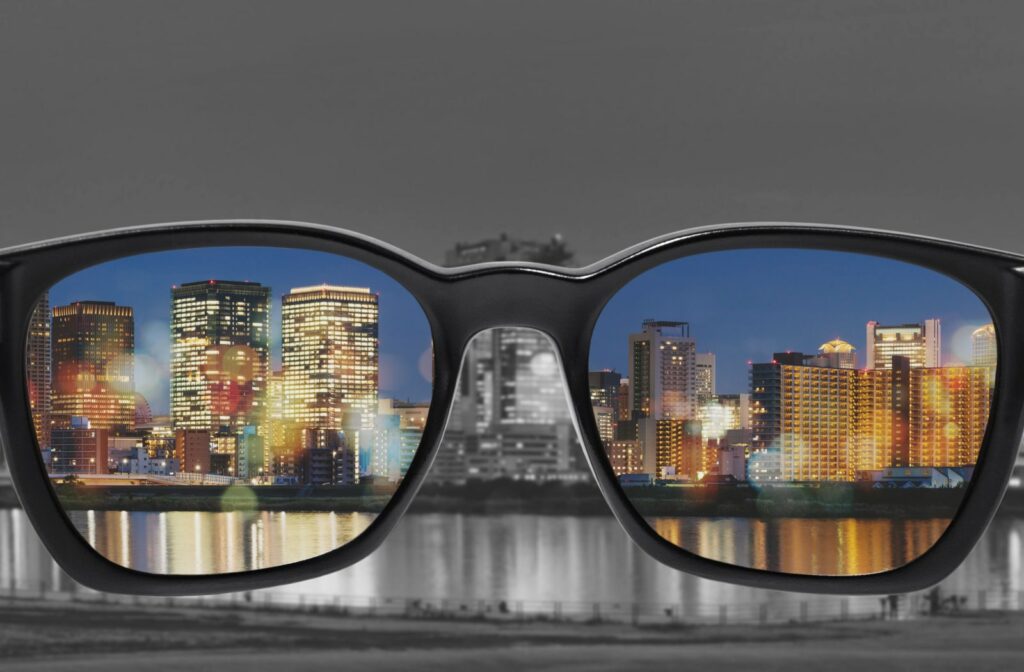Many of us take color for granted. We know the particular shade of blue in the sky, the green in the trees, and the three colors of a stoplight. But these colors can be muddy. That’s the reality for those who have color deficiencies more commonly known as color blindness, a condition typically first diagnosed in children with an eye exam.
However, after conducting extensive research on the different wavelengths of light and how a color blind patient interprets their color, Enchroma glasses were developed. This development opens a new world of colors for those with color deficiencies. Enchroma lenses use special lenses to filter the wavelengths of light before they enter the eye, making colors easier to distinguish for people with certain types of color blindness.
What is Color Blindness?
Color vision deficiency or color blindness is a common condition that affects many people worldwide. In this condition, your eye does not see colors correctly. It’s usually genetic, but there is a slight chance that eye diseases or brain/eye damage can cause it. Risk factors for color blindness include:
- Family history
- Being male
- Having European heritage
- Eye diseases like glaucoma or age-related macular degeneration (AMD)
- Health conditions like diabetes, Alzheimer’s disease, or multiple sclerosis
- Certain medications
- Alcohol use disorder
Color blindness is often misunderstood and can be tricky to explain, but that’s why we’re here! Despite its name, people with color blindness often can still see color. They simply perceive color differently, and in a world where we use color as indicators, that can cause wide-reaching difficulties.
The way color blindness affects a person depends on the type of color blindness they have.

Types of Color Blindness
Color vision deficiency can be classified in a few different ways, but it all comes down to the cones in your eyes. Cones, along with rods, are one of the types of photoreceptors (light sensitive cells) in the retina at the back of your eyes. They give us our color vision, and there are 3 types that each detect one of the 3 primary colors: red, green, and blue.
For people with color blindness, 1 type of cone may see their designated color incorrectly or not see that color at all.
Red-Green Color Blindness
The most common type of color blindness is red-green, with 8% of men and 0.5% of women having it. In color blindness, the part of the light spectrum that ‘red’ and ‘green’ cones detect overlap significantly, so these cones tend to have similar responses to different wavelengths of light. People with red-green color blindness can have trouble distinguishing between reds, greens, browns, and oranges.
Types of red-green color blindness are based on what color of light is affected, such as:
- Green light: The reduced ability to see green light is called deuteranomaly and is the most common type of red-green color blindness. Being unable to perceive any green light is called deuteranopia.
- Red light: Reduced sensitivity for red light is called protanomaly. Protanopia is the complete inability to see red light.
Blue-Yellow Color Blindness
Only about 10% of your cones see blue light, and it’s the less common type of color blindness. People with this type can have trouble seeing between shades of blue and green, and red and yellow.
Blue-yellow color blindness has 2 types:
- Tritanomaly: a reduced ability to see blue light.
- Tritanopia: a complete inability to see blue light.
Monochromacy (Complete Color Blindness)
The third and rarest type of color blindness is complete color blindness. Only about 1 in 33,000 people have this form of color blindness, and individuals with this condition can’t distinguish any colors and see the world in only shades of gray.
The Science Behind Enchroma Glasses
Enchroma glasses were first invented by researchers in California. These glasses use a special kind of lens that enhances the color perception of the wearer in an innovative way — by actually blocking certain colors of light out!
Enchroma glasses don’t just magically make colors appear; they work by selectively filtering specific wavelengths of light. The key is to filter out the wavelengths where the color cones overlap. Typically, these wavelengths cause confusion for those with color blindness. Filtering these wavelengths out enhances the other wavelengths to make colors more vibrant and distinguishable.
Will Enchroma Glasses Work for Me?
Enchroma glasses are designed for people with anomalous trichromacy. These are the 3 types of color blindness where your cones have a reduced ability to see color. They are:
- Deuteranomaly (reduced green)
- Protanomaly (reduced red)
- Tritanomaly (reduced blue)
Anomalous trichromacy accounts for color blindness in 4 out of 5 patients, most of which are deuteranomaly and protanomaly, typically called red-green color blindness. Enchroma glasses are designed to deal with the “confusion line” between red and green, allowing them to address red-green color blindness, so it’s very likely Enchroma glasses can give you a new world of color.
For people with severe red-green color blindness, they don’t have any cones that can see one of those colors. This is called deuteranopia or protanopia. They may see limited results when using Enchroma glasses since they totally cannot see the difference between red and green.
Take the color vision test to learn if Enchroma lenses may work for you.
A World of Color for You
Although the experience of wearing Enchroma glasses varies from person to person, users have reported an improvement in their color perception. For some, it’s an emotional experience as they see colors they’ve never seen before, bringing tears to their eyes. For others, it’s a practical tool that helps them distinguish between colors, making it easier to match clothes or perform certain tasks.
While they may not work for everyone, those with mild to moderate color blindness may benefit from wearing Enchroma glasses. Perry Eyecare & Morgan Eyecare proudly offer prescription and non-prescription Enchroma glasses for people with red-green color blindness.
If you want to learn how Enchroma glasses could help you see the colors of the rainbow, book an eye exam today!



